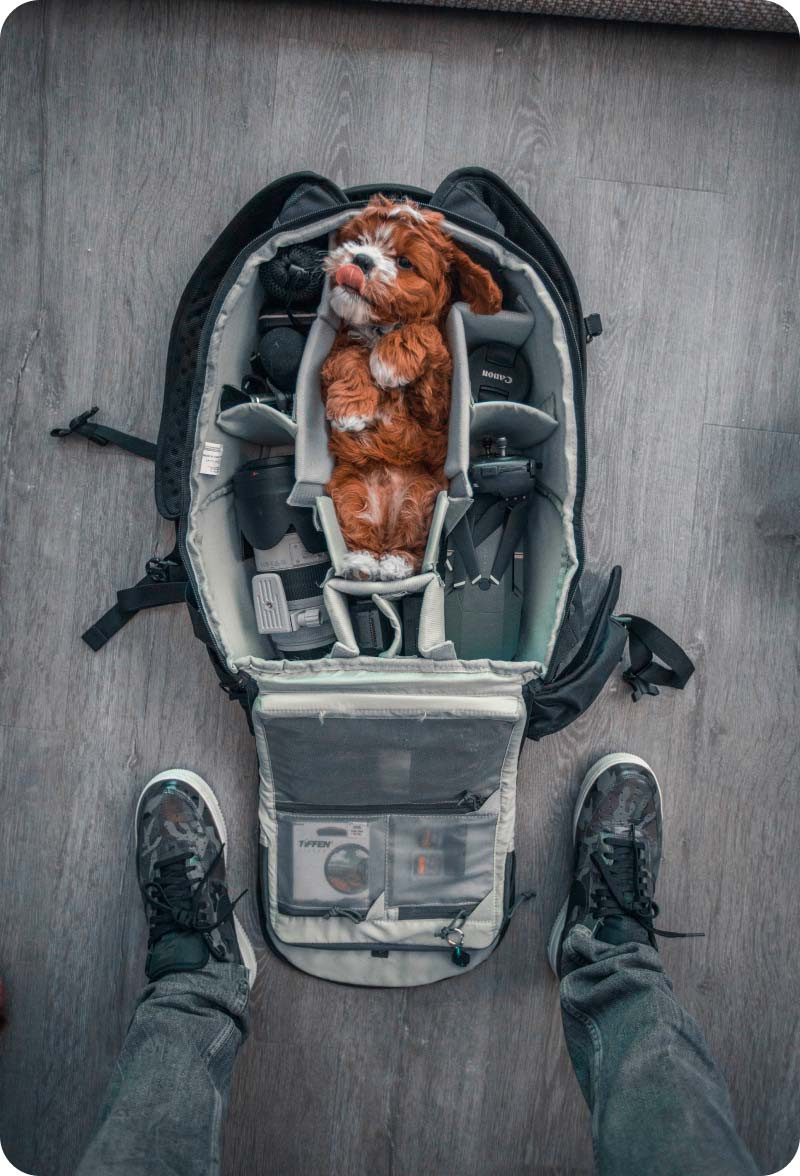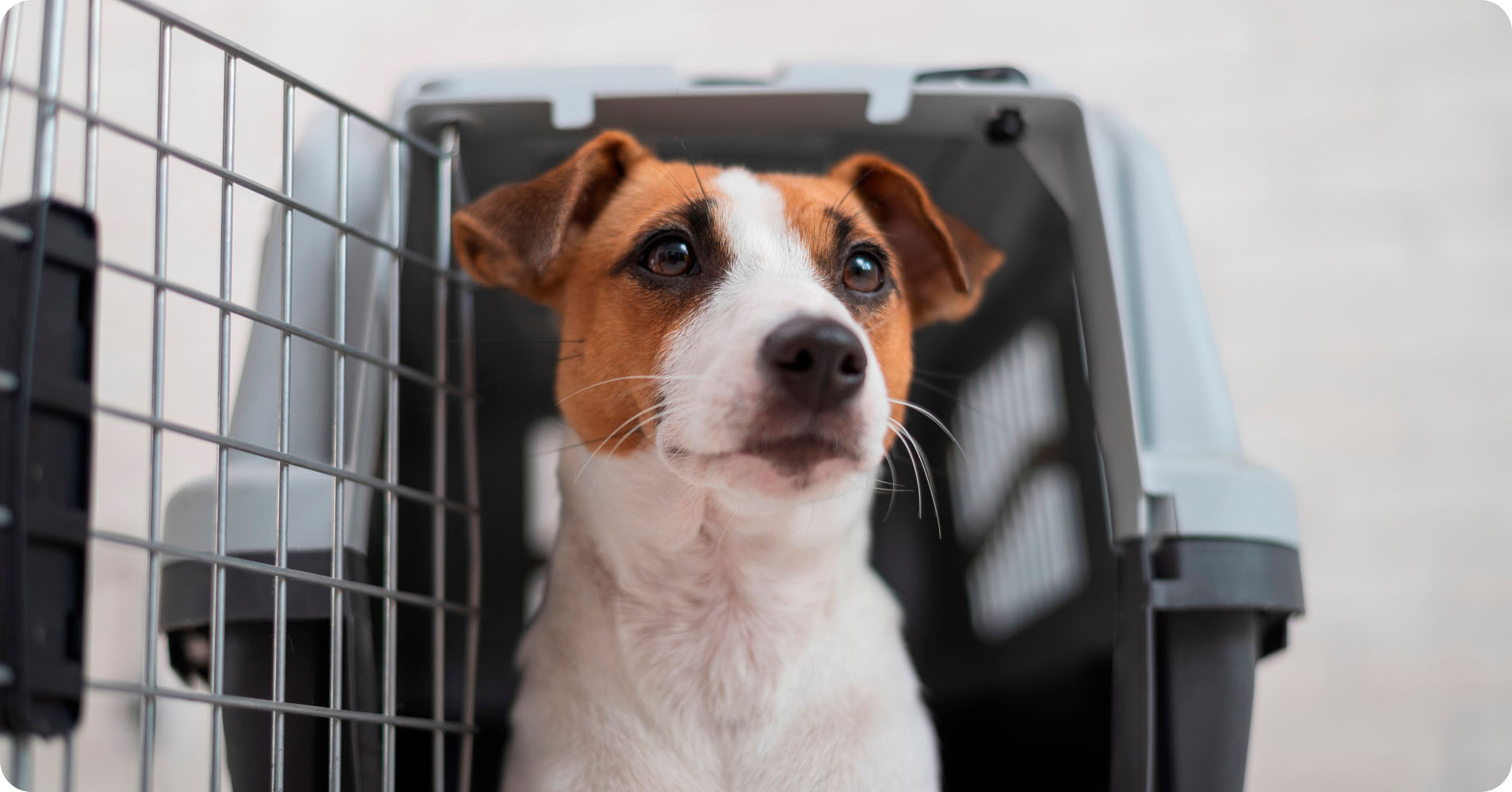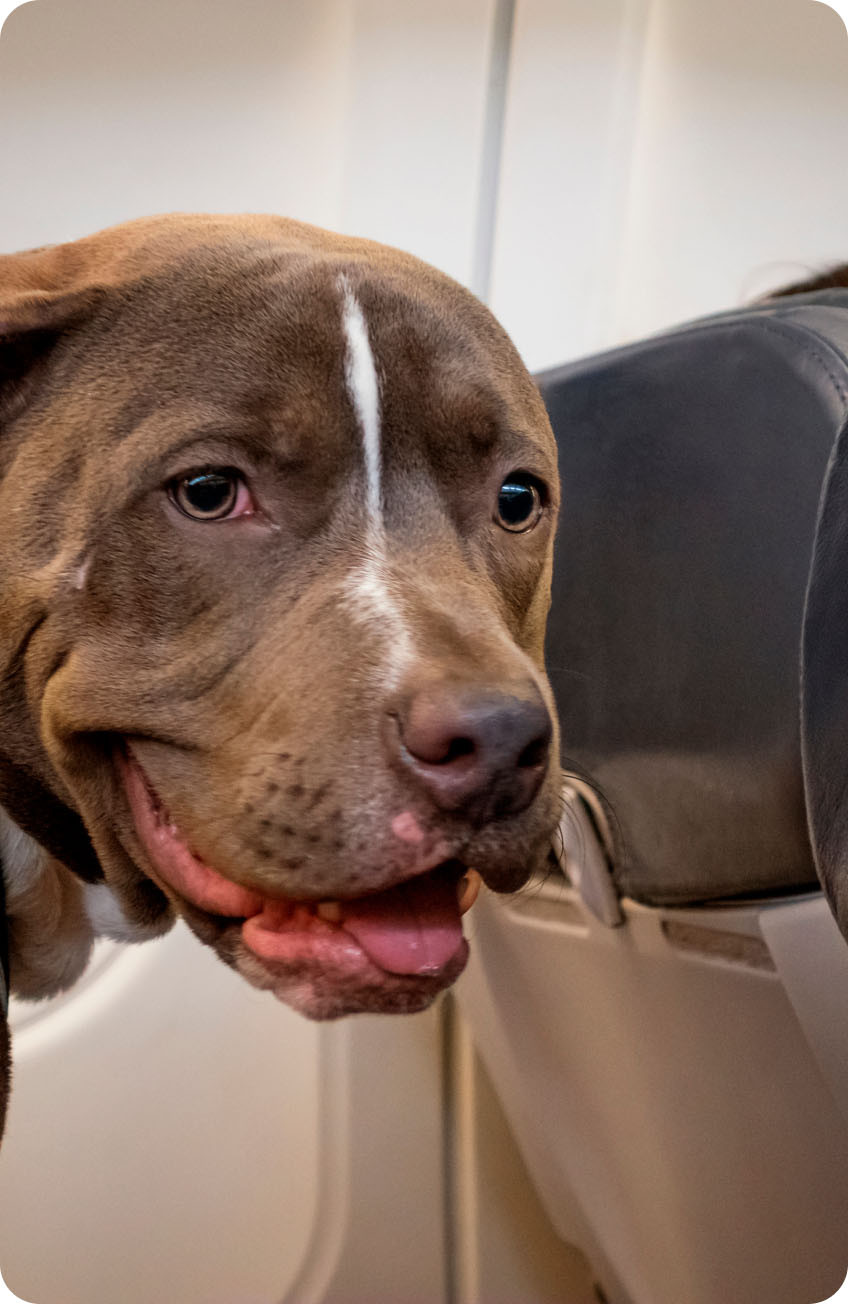The rules around flying with emotional support animals (ESAs) have changed significantly in recent years, leading many pet owners to wonder if their ESA dogs can still fly for free. In March 2021, the Department of Transportation (DOT) revised its regulations, granting airlines greater discretion over the transportation of ESAs. This shift means that the answer to “Do Esa Dogs Fly Free?” is no longer straightforward and largely depends on the specific airline’s policies.
Unfortunately, emotional support animals are not classified as ‘service animals’ under the Air Carrier Access Act (ACAA). This distinction is crucial because service animals, particularly psychiatric service dogs, retain federal protections for air travel, while ESAs do not. Consequently, airlines are now free to establish their own rules regarding ESAs, and the majority have opted to treat them as standard pets, subject to fees and restrictions. However, it’s not all bad news for ESA owners. Some airlines, especially those outside the US and some smaller carriers, still offer more accommodating policies for emotional support animals. Conversely, all airlines are mandated to accommodate psychiatric service dogs, highlighting a key difference in animal classifications and air travel regulations.
[Go Deeper
Do I Qualify For A Psychiatric Service Animal Quiz
Mental health conditions affect a significant portion of the population, with 1 in 5 Americans experiencing mental health illnesses, disorders, or illnesses. For these individuals, a Psychiatric Service Animal can be incredibly beneficial in managing their mental health challenges.
](https://pettable.com/blog/do-i-qualify-for-a-psychiatric-service-animal-quiz)
Why Most Airlines No Longer Accept Emotional Support Animals
The change in DOT regulations stemmed from the reclassification of emotional support animals. Since ESAs lack the specific training of service animals and are not protected by the ACAA, most airlines now categorize them as pets. This means ESAs are subject to standard pet policies, which typically involve fees, size restrictions, and kennel requirements. In contrast, physical and psychiatric service dogs (PSDs) are still permitted to travel in the cabin with their handlers without charge on all airlines, provided they adhere to airline-specific guidelines. If your ESA is not a dog (or a psychiatric service dog of any breed), you will likely need to adhere to pet travel protocols on major airlines like American, Delta, United, Southwest, and Frontier.
 A medium-sized dog sits patiently at an airport gate, with people and luggage carts visible in the background.
A medium-sized dog sits patiently at an airport gate, with people and luggage carts visible in the background.
Traveling with Smaller Pets: Options for Dogs Under 20 Pounds
Even with the changes in ESA policies, airlines still accommodate small pets. If your dog or cat weighs under 20 pounds and can comfortably fit in an airline-approved pet carrier beneath the seat in front of you, you can generally bring them onboard for a fee. This option applies to pets regardless of whether they were previously considered ESAs.
However, this policy offers limited help for owners of larger dogs, who now face significant challenges when traveling with pets exceeding the weight limit. This can disrupt travel plans and add stress for pet owners who rely on the companionship of their larger animals.
Federal Protections Remain for Service Animals
Service Animals continue to be protected under federal law, ensuring that airlines must accommodate them in the cabin. This protection exists because service animals are recognized as working animals, individually trained to assist individuals with disabilities. A fully trained service dog that meets airline requirements is permitted to fly in the cabin at no charge, typically sitting at the owner’s feet.
These animals are distinguished by their exceptional behavior and specialized training to perform tasks that directly aid a person with a specific disability. Psychiatric service dogs fall under this protected category, and we will explore their role and the definition of “well-behaved” service animal in more detail later.
Airlines Still Accommodating Emotional Support Animals
While the landscape for ESAs on major airlines has shifted, a few international carriers, particularly in Central and South America, continue to welcome ESAs for in-cabin travel.
LATAM Airlines
LATAM Airlines, headquartered in Santiago, Chile, is a prominent airline in Latin America with global routes. Known for its pet-friendly approach, LATAM Airlines accommodates both service dogs and emotional support dogs or cats on flights to and from Colombia and Mexico, as well as on domestic Colombian flights. A significant advantage for ESA owners is that ESAs travel free on these routes. This benefit typically applies to dogs and cats that can fit in a carrier placed under the seat. However, certain breeds considered potentially dangerous or dogs exhibiting aggressive behavior are not permitted in the cabin. LATAM also limits the number of support animals to six per flight.
Volaris
Volaris, a leading low-cost airline based in Mexico City, operates throughout the Americas. Volaris permits assistance animals, specifically cats and dogs, to fly without charge on flights within Mexico, Central America, and South America. To travel with your ESA on Volaris, you will need an official ESA letter issued by a licensed mental health professional (LMHP) within the past year. The animal must weigh no more than 26 pounds. Interestingly, Volaris does not always require ESAs to be in a carrier; in some instances, a leash or harness is sufficient, allowing your pet to travel on your lap.
Aeromexico
Aeromexico, Mexico’s flag carrier based in Mexico City, serves destinations across the Americas, Caribbean, Europe, and Asia. Aeromexico welcomes both dogs and cats as ESAs, provided they are small, weighing 26 pounds or less. These ESAs can travel on your lap or in an approved carrier that fits under the seat. It’s important to note that accommodations may be adjusted to consider the needs of other passengers, particularly those with allergies, potentially requiring seat changes. Furthermore, the animal must maintain good behavior throughout the flight, including boarding and deplaning.
 A woman is holding a small, light-colored dog in her arms while seated. She is smiling and looking at the dog.
A woman is holding a small, light-colored dog in her arms while seated. She is smiling and looking at the dog.
Major Airlines and Pet Policies: Fees and In-Cabin Travel
Despite the changes in ESA policies, many major airlines still permit small pet dogs or cats to travel in the cabin with you for a fee. This applies whether or not the animal was previously designated as an ESA. Airlines with such policies include:
- Alaska Airlines
- Southwest Airlines
- United Airlines
- American Airlines
- Delta Airlines
- Hawaiian Airlines
Transitioning from ESA to Psychiatric Service Dog: Is it Possible?
The primary distinction between an emotional support dog and a psychiatric service dog lies in training. If you are considering transitioning your ESA dog to a psychiatric service dog, specialized training is the key. Pettable offers resources to guide you through this process. They can connect you with a licensed mental health professional (LMHP) for evaluation and diagnosis, and provide access to online PSD training programs. Upon completion, you can obtain a PSD letter confirming your need for a psychiatric service dog.
Get Your PSD Training Plan
Essential Steps for Smooth Air Travel with Your Pet
To minimize potential issues when flying with your ESA dogs, cats, or other pets (when permitted), consider these recommendations:
Secure a Comfortable and Spacious Seat
Whenever possible, request a seat in the front row, as these typically offer more legroom. Extra space can significantly enhance your pet’s comfort during the flight, reducing stress and anxiety. Take advantage of early boarding options often available for individuals with disabilities, families, or active military personnel. Early boarding allows you to settle in and ensure your pet is comfortably situated before the general boarding process begins.
 A small dog is curiously looking out of a partially zipped suitcase that is lying on the floor.
A small dog is curiously looking out of a partially zipped suitcase that is lying on the floor.
Prioritize Your Pet’s Health and Well-being Before Travel
Before your flight, assess your pet’s health and typical travel behavior. Consider these questions:
- Has your pet been unwell recently?
- How does your pet usually handle travel? Do they require calming aids or specific preparations?
- If your pet is new to flying, how do they react to car rides or unfamiliar environments?
Generally, ensure your pet is fit to fly and can manage potential travel stress. Traveling with a nervous or unwell pet can be stressful for both you and your animal, potentially increasing your anxiety and negatively impacting your mental health.
Ensure Your Pet Exhibits Good Behavior
Having a well-behaved pet can significantly simplify your travel experience, regardless of whether they are an ESA or simply traveling as a pet. While ESAs are not required to perform specific tasks like service animals, good behavior is crucial for smooth travel. Airlines that permit pets in the cabin expect them to be well-mannered and non-disruptive.
A well-trained pet is less likely to attract unwanted attention or questions, making the boarding process smoother. Conversely, disruptive behavior may lead to your pet being denied in-cabin travel and potentially being checked as cargo.
Contact Your Airline in Advance
It is always recommended to contact your airline directly before your flight, especially when traveling with an ESA or pet. Inquire about any specific requirements or documentation they may need for animals traveling in the cabin. Airlines often appreciate advance notice, ideally at least 48 hours before your flight, and some may want to know about your pet at the time of booking.
Carry All Necessary ESA Documentation
If you are flying with an ESA on an airline that still accepts them, ensure you have all the required documentation. Typically, this includes your ESA letter from a licensed mental health professional. It’s wise to keep both a digital copy on your phone and a printed copy of your ESA letter for easy access.
Psychiatric Service Dogs: Guaranteed Cabin Access on All Airlines
For travelers with mental disabilities, psychiatric service dogs (PSDs) offer a reliable avenue for air travel. The Air Carrier Access Act (ACAA) explicitly prohibits discrimination based on disability in air travel, as affirmed by the Department of Transportation. If you are traveling internationally with a PSD, it is essential to research the service animal regulations of your destination country, as they may differ from US regulations.
Understanding Psychiatric Service Dogs
A psychiatric service dog is similar to an ESA in providing comfort and support but goes further by being specifically trained to perform tasks that directly assist with a person’s disability. Psychiatric service dogs and service animals, in general, have become the recognized standard for air travel for individuals with qualifying disabilities.
Key Differences Between PSDs and ESAs
Psychiatric service dogs differ from emotional support animals because they undergo specific training to perform work or tasks directly related to the handler’s disability. The criteria for mental and emotional disabilities that qualify for a psychiatric service animal are the same as those for ESAs.
 A small dog is inside a soft-sided pet carrier, which is placed on a seat in what appears to be an airplane cabin.
A small dog is inside a soft-sided pet carrier, which is placed on a seat in what appears to be an airplane cabin.
Qualifying Disabilities for Psychiatric Service Dogs
The range of mental or emotional disabilities that can qualify an individual for a psychiatric service animal is broad and includes conditions such as:
- Depression
- Anxiety
- Phobias
- Personality Disorders
- Bipolar Disorder
- ADHD
- Schizophrenia
Psychiatric service dogs and service animals provide the same type of mental health support as emotional support animals, but with the added benefit of task-training.
Training Standards for Psychiatric Service Dogs
Psychiatric service animals must meet two primary training standards to be classified as service animals:
Maintaining Public Behavior Standards
First, PSDs must be well-behaved in public settings. While the standard is somewhat subjective, generally, service animals should not exhibit signs of stress, jump on people, chase other animals, eliminate indoors, and must remain composed throughout a flight and in other public environments. Failure to meet these behavioral standards may lead to questioning of their service animal status and potential denial of cabin access.
Task Training for Disability Assistance
Service animals must be trained to perform specific tasks that directly benefit the owner’s mental health disability. This task training is what distinguishes them from ESAs and is essential for them to be recognized as service animals and permitted in the cabin.
PSDs can be trained in a variety of tasks to support mental health, including:
Reducing Anxiety and Depression Symptoms
Tasks can include deep pressure therapy like laying on the lap or chest, nudging or pawing to interrupt rumination and negative thought patterns. Simply petting a PSD can also release calming hormones and slow a racing heart rate.
Alleviating Claustrophobia
For individuals with claustrophobia, which can be particularly triggered by air travel, a PSD can create a comforting buffer zone between the handler and others, especially in confined spaces like airplane cabins.
 A medium-sized dog is sitting calmly in the aisle of an airplane, looking towards the camera, with rows of seats visible in the background.
A medium-sized dog is sitting calmly in the aisle of an airplane, looking towards the camera, with rows of seats visible in the background.
Providing Medical Support and Reminders
A PSD can be trained to remind their handler to take medications, which is especially important during travel when routines are disrupted and stress levels may be higher.
Mitigating Sensory Overload and Stress
In high-stimulus environments like airports and airplanes, a PSD can provide crucial support by offering a distraction, applying tactile pressure, or performing other tasks to reduce stress and sensory overload.
Assisting with Balance Issues
For travelers experiencing dizziness or fatigue related to medication or mental health conditions, a PSD can provide balance assistance and stability.
Interrupting Night Terrors
PSDs can be trained to wake their handlers from night terrors, providing comfort and interrupting distressing episodes during travel.
Encouraging Solitude When Needed
For individuals who become overwhelmed in social situations, a PSD can be trained to encourage them to seek solitude and take necessary breaks from draining environments.
Required Documentation for PSDs
While technically no documentation is legally mandated beyond the dog’s training for PSDs, many handlers obtain a PSD Letter as formal confirmation of their need for a psychiatric service dog.
It is crucial to remember that before flying, PSDs must meet the training standards established by the ADA and DOT. If your dog requires PSD training, online PSD training programs are available for self-training.
Additionally, the DOT requires handlers to complete a form before flying with a PSD. This DOT form can be accessed online.
Psychiatric Service Dog Training
Training a psychiatric service dog involves teaching specific tasks to mitigate your mental disability and ensuring the dog is reliably obedient in public. Professional trainers are not required; self-training is permitted. Online PSD training programs, guided by certified trainers through instructional videos, can facilitate this process at your own pace. To begin PSD training, start with an online assessment to determine your eligibility for a PSD.
Train Your Own PSD
 A small dog with floppy ears is peeking out from a dark-colored pet carrier bag. Only the dog's head and front paws are visible.
A small dog with floppy ears is peeking out from a dark-colored pet carrier bag. Only the dog's head and front paws are visible.
Obtaining a PSD for Travel: A Simple Process
If you believe a psychiatric service dog is right for you, the process to obtain one is straightforward. Start by taking an online quiz to assess your needs.
Consultation with Mental Health Professionals
The quiz gathers information to connect you with a mental health professional suited to your specific situation. Following the quiz, you will be connected with a licensed mental health professional experienced with PSDs and licensed in your state for a consultation.
Flexible Timelines and Express Services
With a broad network of clinicians across all states, consultations can be scheduled quickly, often with express services guaranteeing a consultation within 24 hours.
Satisfaction Guarantee
Reflecting confidence in their mental health professionals and services, a satisfaction guarantee is offered, providing a 100% refund if the ESA letter or PSD training program does not meet your needs.
What Defines an Emotional Support Animal?
An emotional support animal is defined as any animal that provides comfort and alleviates symptoms of a mental or emotional disability. Unlike service animals, ESAs do not require specific training to perform tasks; their primary role is to offer therapeutic presence and companionship. The benefit of an ESA lies in its ability to provide comfort and support, directly addressing symptoms of mental health conditions like anxiety, depression, phobias, or PTSD.
While dogs and cats are the most common ESAs, a wide range of animals can qualify, including rabbits, birds, fish, and even less conventional species, as long as they provide emotional support to their owner.
Distinguishing Emotional Support Animals from Service Animals
A key distinction between service animals and emotional support animals is that service animals are almost exclusively dogs (or sometimes miniature horses). Under the Americans With Disabilities Act (ADA), service animals are granted access to nearly all public spaces.
These animals are specifically trained to perform tasks related to a person’s disability, such as guiding the visually impaired, alerting the hearing impaired, or assisting during medical emergencies like seizures or panic attacks. While service dogs often assist individuals with physical disabilities, they can also support those with mental and emotional disabilities.
The critical difference between a psychiatric service dog and an ESA is the level of training. ESAs have no mandated training requirements, whereas service dogs must undergo rigorous training to perform specific tasks and exhibit impeccable public behavior.
The process for obtaining either an ESA or a psychiatric service dog letter involves a consultation with a licensed mental health professional to evaluate your mental health symptoms and determine the necessity of an assistance animal.
How Emotional Support Animals Provide Therapeutic Benefits
Each emotional support animal offers unique support to its owner through companionship and comfort. While often compared to service animals, ESAs differ significantly as they are not required to perform specific tasks. The core function of an ESA is to provide therapeutic companionship, offering comfort and emotional support simply through their presence. While some ESAs, especially dogs and cats, may have some basic training, it is not a prerequisite.
Importantly, emotional support animals do not have the same legal rights as service animals, which is a critical consideration when planning air travel, especially with less common ESA species.
Common Types of Emotional Support Animals and Their Benefits
Emotional support animals come in diverse forms. Dogs are most prevalent, but any non-threatening animal that provides support can be an ESA. Beyond dogs, rabbits, snakes, birds, monkeys, and many other species have been recognized as ESAs.
Here are some common emotional support animals and their specific benefits:
Dogs
Dogs, known for their loyalty and companionship, are the most common ESAs. While ESAs don’t require training, dogs are trainable and can learn tasks beneficial for emotional and mental disabilities. With additional training, an emotional support dog can often become a psychiatric service dog, gaining cabin access even when ESAs are restricted.
Cats
Cats are the second most popular ESA choice. Research indicates that interacting with cats can reduce tension and anxiety, and even lower blood pressure and cholesterol. Cats are typically calm and quiet, exhibiting minimal disruptive behavior, making them suitable travel companions. While cats cannot become service animals, they excel as emotional support animals.
Birds
Birds can be a source of joy and upliftment for their owners. Parrots, cockatoos, parakeets, and other bird species can become ESAs. Their vibrant colors and cheerful sounds can be particularly beneficial for individuals struggling with depression or anxiety. Some bird species are trainable and can learn phrases or sense emotions, enhancing their support capabilities.
Miniature Horses
Miniature horses, known for their trainability and emotional intelligence, can sometimes qualify as service animals. In certain cases, a miniature horse that is a trained service animal may be permitted on airplanes. They can also serve effectively as ESAs, particularly for those with sufficient space to accommodate them.
Rabbits
Rabbits are social animals that form strong bonds with their owners. They offer comfort and affection as pets and ESAs. Surprisingly intelligent, rabbits can be trained to follow commands and perform tricks, enhancing their interaction with their handlers.
Snakes and Lizards
For individuals with fur allergies or those who prefer reptiles, snakes and lizards can be excellent ESAs. They are quiet, low-maintenance, and can be affectionate in their own way.
Pigs
Pigs are gaining popularity as ESAs due to their friendly nature and intelligence. They can understand instructions and are relatively clean if properly cared for. However, airline cabin access for pigs is unlikely.
Hedgehogs
Hedgehogs can be loving ESAs for those who understand their care. They enjoy owner attention but require specific care. Ownership legality varies by location, so it’s essential to check local regulations before traveling with a hedgehog.
Uncommon Species as Emotional Support Animals
For those not seeking a service animal (which is almost always a dog), there are no species restrictions for ESAs. Any animal that provides therapeutic benefit for a mental health condition can be considered an ESA.
Unusual ESAs have included kangaroos, bearded dragons, turkeys, marmosets, peacocks, ducks, and chickens. However, for ease of travel and general companionship, dogs or cats often remain the most practical choices.
Airline Policies on Unique Emotional Support Animals
Due to changes in the Air Carrier Access Act, most airlines now classify emotional support animals as pets, significantly limiting in-cabin acceptance. Airlines still accepting ESAs may require documentation, such as an ESA letter from a mental health professional, verifying the need for the animal.
While small ESAs or pets (dogs, cats, rabbits, ferrets) may be allowed in the cabin for a fee if they fit in a carrier, unique ESAs like large birds or pigs are typically prohibited from cabin travel.
Always verify the specific airline’s current policies regarding animal travel before making plans, whether for pets or ESAs. Traveling with unusual ESAs may present significant logistical challenges and air travel may not be the most suitable option.
Frequently Asked Questions
Can you take an emotional support animal on a plane in 2024?
Due to recent amendments to the Air Carrier Access Act, airline policies vary. Most US domestic airlines no longer accept ESAs in the cabin. Always confirm the airline’s current policy before traveling.
What animal is best for anxiety and depression on a flight?
Dogs and cats are commonly chosen as ESAs for anxiety and depression. However, as most airlines now treat ESAs as pets, they must travel in approved carriers under the seat and may incur fees.
Can you take an ESA on an international flight?
Some international airlines like Air France, KLM, Lufthansa, Asiana, and Singapore Air may still accept ESAs, particularly emotional support dogs, and may require ESA letters. Always verify the specific airline’s policy before booking international flights.
